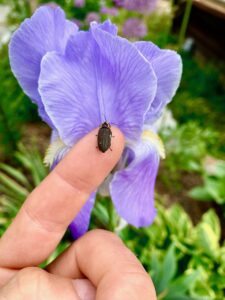I should have known the chickens would not go into their coop until it was properly dusk. I had stopped in at my mom’s place to shut the chickens in for the night while she was away and found them all still outside. It was 7:30 p.m., still light out, but I was in a hurry, hoping to bend age-old natural cycles to fit my own schedule.
I found them out in the pen, as expected, huddled together, defiant. You can’t rush chickens. It never works. If you try, they get agitated and scatter and your attempt to hurry things backfires; the whole process ends up taking longer. I would have to come back later, on their schedule, when it was dark.
An hour and a half later, the sky held a dusky purple glow that I would have thought was black if the true deep black of the silhouettes of oaks and pines had not lain over it in contrast. The night was humid, the warm air of the longest days saturated with moisture from recent thunderstorms and rainfall. I parked my car and stepped into the darkness, feeling my way with bare feet along a familiar narrow path of pine needles.

As my eyes adjusted, I saw a warm amber flash in the dark ahead of me. Then another. And another, off in the woods. I stopped and turned my attention from the little unseen trail I was following and looked out into the wider world around me. My breath was stilled by what I saw. As far off into the woods as my sight could go, yellow, orange, and green sparks lifted and settled in soft arcs. Little drifting flares burned bright, blinked, and were extinguished. So many lights surrounded me, I felt I stood in the center of a galaxy-in-creation. Fireflies. How perfectly named. Thousands of them calling to one another in the vast night.
As is true of all energetically expensive displays in nature, the glowing of the fireflies is done only on certain occasions. They light up for defense. Their glowing can signal the presence of toxins, but it serves primarily as communication in mating. They flash and call so that they may fill future summer nights with the brightness of their offspring. The males drift about in the dark, drawing oxygen through their tracheoles into their low abdomens, sparking a chemical bioluminescence to signal to females. The females rest on foliage, unseen, until they signal back to a chosen male. Eggs are laid in the damp ground and hatch a month later. The larvae feed through the rest of the summer and go into hibernation through the winter in the soft earth and in the furrows of tree bark. The larvae emerge again in the warming days of spring to feed on worms, slugs, and other insects before pupating into adult beetles. Then, on the first warm nights of summer, they lift into a soft breeze and wander like the stray embers of some far-off bonfire.
Had I stuck to my own plans, I would have missed all of this. I’m grateful to the chickens for keeping me outside after dark and to the fireflies for showing me why their schedules matter at least as much as mine do. Being made to wait has its purpose, I thought. It might be a good idea to slow down.



